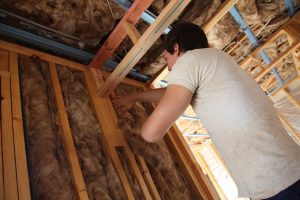Pole barns are deeply rooted in American history with origins dating to the 1930s. During the great depression, construction materials were expensive and most farmers didn’t have much money to spare. With a little ingenuity, farmers realized they could use utility poles to support the rafters for a barn. Farmers across the country started using the cheaper utility poles and thus the pole barn was born.
Understanding Pole Barns and Their Uses
As the economy and materials improved, utility poles weren’t used as often, but the pole barn design lived on. Nowadays, most modern pole barns use steel poles and stronger trusses and columns. Due to the strength of these materials, pole barns can be used for a variety of different uses too. Modern pole barns are used for agriculture of course, but can also be utilized as a workshop, horse stable, garage, man cave, and even homes. Imagination is the only limitation when it comes to the use for pole barns.

Why is Heating a Pole Barn Necessary?
Regardless of how you use your pole barn, you’ll need to be able to heat it to make it usable during the winter months. How your pole barn will be used will be a factor in deciding how to heat it. Depending on how the building will be used, the local building codes may actually require the pole barn to be heated. If the pole barn has pipes, you’ll want to make sure they’re insulated and the building is heated to prevent burst pipes as well.
Insulated vs. Uninsulated Pole Barns
Before determining how to heat a pole barn, it is important to know if the pole barn will be insulated or uninsulated. Uninsulated pole barns are cheaper, but they are harder and more expensive to heat. Since hot air rises, as the air inside the pole barn is heated the hot air will collect toward the ceiling. Without insulation, the heat seeps through the roof and is wasted.
While more difficult to heat, it is certainly possible to heat an uninsulated pole barn. Radiant heaters tend to work better in uninsulated pole barns because they do a better job of heating the people and surfaces inside of the building instead of the air.
Regardless of the heating system chosen, if the pole barn will be heated a good portion of the year it typically makes sense to add insulation first.

Ways to Heat a Pole Barn
Luckily for pole barn owners, there are quite a few ways to heat a pole barn. The size of the structure and heating requirements will often be factored into the choice for heating system. Oftentimes cheaper heating systems cost more to operate and vice versa, so it’s important to keep that in mind.
1. Wood and Pellet Stoves
Wood and pellet stoves are a fairly cheap and easy way to heat a pole barn. If you have excess wood to burn, running a wood fired stove may be the lowest cost way to heat your pole barn through the winter.
Some downsides to burning wood are the poor air quality, the space required, and the attention required. Burning wood can cause polluted indoor air which is why ventilation is essential. To clean the air up, you can also switch to cleaner burning wood pellets which cost around $5 per 40lb. bag. Most wood fired stoves require a decent amount of clearance around the stove itself. You also don’t typically want to run these types of wood burners without someone present to monitor them, although more modern versions have many safety features.

2. Furnace
If the pole barn is insulated, it often makes sense to heat just as you would your home. Gas fired or electric furnaces are a great way to keep your pole barn comfortable all winter long. If the pole barn has a gas line, adding in a gas furnace is rather simple. Furnaces don’t take up too much room and can be coupled with controls to automatically keep the pole barn at the desired temperature. Electric furnaces are rather simple too, as long as the pole barn has enough available power.
Furnaces are often referred to as forced air systems because they use ductwork and a fan to pull and push air around the building. Even with simple ductwork it’s easy to get a really comfortable and evenly heated space. If used in an uninsulated pole barn, it’s important to remember that the furnace will have to work much harder and the energy bill will go up along with it.

3. Radiant Heaters
Radiant heaters work by heating the people and objects in an area instead of the air itself. Because of this, radiant heaters work great in drafty or uninsulated pole barns. Radiant heaters also work great if there are only certain areas of the pole barn that need to be heated. Many radiant heaters run on natural gas, but modern styles can operate on electricity too. Radiant heaters are often a bit bulky and won’t feel quite as comfortable as other heating options but can be highly effective when used appropriately.

4. Radiant Floor Heating
Radiant floor heating takes many of the positives from radiant space heaters and gets rid of the negatives. Radiant floor heating systems are installed underneath the flooring system in your pole barn. The heating system is distributed evenly throughout the entire pole barn floor and gently heats upwards from the ground, up to 6’. This is extremely useful, especially in a pole barn, as no energy is wasted heating areas that do not need to be heated.
Radiant floor heating systems warm people and objects instead of the air, just like radiant space heaters, but because the entire floor is being heated people are wrapped in warmth when in the pole barn. These systems are highly economical too because they are not wasting energy heating the air which can seep right out of the pole barn.
Radiant underfloor heating systems can be more expensive to install than other options and require the floor to be installed at the same time. Radiant floor heating options should be top of the list for anyone trying to heat a pole barn.

For The Best Pole Barn Heating Option, Trust in Warmup Radiant Floor Heating Solutions
Pole barns have been around for almost a hundred years and, while their uses may have changed, the need to heat them has not. When deciding how to best heat your pole barn, look at all the options out there and decide what your needs are for heating the pole barn in the first place.
If you’re looking for an energy efficient and space saving way to make your pole barn comfortable all winter long, look no further than Warmup radiant floor heating solutions. Reach out to the experts at Warmup today to start planning your pole barn heating system.
